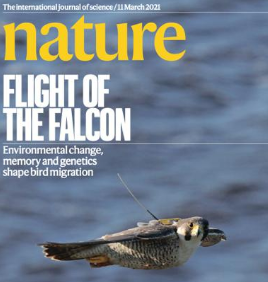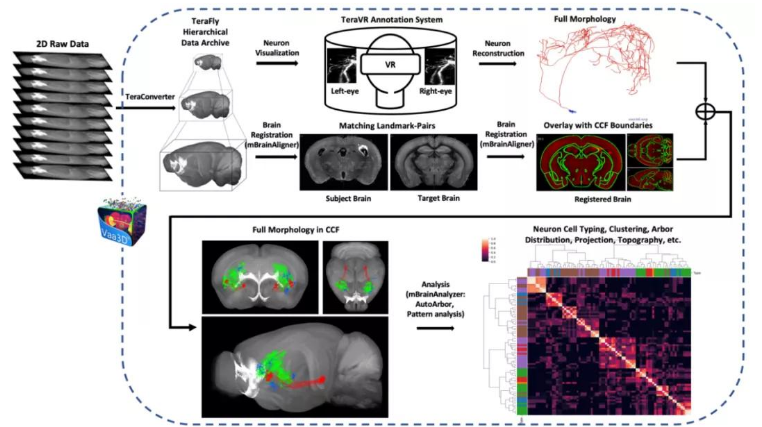The "Top Ten Advances in China's Life Sciences" in 2021 was announced
The results have been published in the journal Cell (2021, 184(13):3438-3451.e10) and the Journal of the European Molecular Biology Organization (EMBO J, 2021, 41(1):e109962).
8. Uncover the mystery of long-distance bird migration
Bird migration is one of the most watched natural wonders. The formation process, maintenance mechanism and future trend of migration routes under climate change, as well as the genetic basis of migration strategies, have been the focus and difficulty of academic research.

A team from the Institute of Zoology of the Chinese Academy of Sciences (CAS), Zhan Xiangjiang, spent 12 years integrating years of satellite tracking data and population genomic information to establish a continent-scale migration research system for Arctic peregrinus Falco peregrinus. The researchers elucidated the role of climate change in the formation, maintenance and future trends of bird migration routes, and found that a gene associated with memory ability, ADCY8, was positively selected in populations of peregrine falcons that migrated over longer distances, suggesting that long-term memory may be an important basis for long-distance migration in birds. The study fully integrates new research methods such as remote sensing satellite tracking, genomics, and neurobiology, demonstrating the key role of interdisciplinary innovative research in answering major scientific questions.
The work was published as a cover article in the journal Nature (2021,591 (7849):259-264) and was named one of 12 annual reviews by Nature Ecological Evolution.
The cover of Nature magazine and the Arctic Peregrine falcon migration route
9, interference single molecule positioning microscope
The physiological processes of cells are carried out by nanoscale biomolecules, so a deeper understanding of life activities requires imaging techniques with nanoresolution. The technical research team composed of Academician Xu Tao Group and Ji Wei Group of Institute of Biophysics, Chinese Academy of Sciences, has been focusing on the research of breaking through the resolution of optical microscopic imaging. The pre-developed ROSE microscope has improved the lateral (X-Y) resolution to the nanometer level (Nature Methods, 2019). Based on the innovative principle of interference localization, ROSE-Z microscope was developed, which further broke through the axial (Z) resolution and could resolve the nanoscale subcellular structure, providing a powerful tool for life science research. The research shows that the optical microscope has entered the era of nanometer resolution, and Chinese scientists have the ability of interdisciplinary technological innovation in this field, and the new super-resolution imaging equipment with independent intellectual property rights is in the leading position in the world.
The results are published in the journal Nature Methods (2021, 18:369-373).
The hollow structure of cell microtubules was analyzed by interferometric single molecule localization microscopy

10. Whole brain single neuron diversity research and informatics big data platform
Single-neuron precision whole-brain mapping is crucial to understanding the brain. The team of Peng Hanchuan, Gu Zhongze and Xie Wei from the Institute of Brain Science and Intelligent Technology of Southeast University established the world's first complete whole brain single neuron resolution big data and informatics platform and applied it to the whole mouse brain research, and carried out high-throughput neuron reconstruction, whole brain mapping and intelligent data mining for the whole brain three-dimensional image data of neurons. Based on this platform, we produced the largest single cell neuron morphological dataset in the world, revealing for the first time the long-term projection rule and the diversity of neuron morphological subclasses on the basis of molecular level. It continues to play an important role in the study of brain cell classification and function, brain connectivity circuits, whole-brain large-scale simulation, brain-like computing, and new artificial intelligence algorithms and systems based on biological brains. This achievement realizes the first PB-level hyperscale brain big data platform combined with hardware and software and the first complete single cell morphology data production pipeline, which quantitatively proves that complete single cell anatomy analysis is crucial for the identification of nerve cell types.
The main research results were published in Nature (598:174-181;). And "Nature Methods" (19:111-118).
Complete neuronal morphological imaging, reconstruction, registration, analysis platform and process in the whole brain
According to reports, since 2015, the Association of Life Science Societies of China Association for Science and Technology has carried out the annual "Top Ten Progress in China's life sciences" selection work, aiming to promote life science research and technological innovation, and fully demonstrate and publicize major scientific and technological achievements in the field of life science in China. At present, the selection activity has been carried out for 7 consecutive years. After the selection results are announced every year, the selected project experts are invited to write and publish popular science books, and exchange meetings and popular science reports for teenagers are held to reveal new mysteries of life science to the public, provide new ideas for the development of new life science technologies, new medical breakthroughs and the development of bioeconomy, and greatly improve the social influence of life science and related technologies.
- EMERSON
- Honeywell
- CTI
- Rolls-Royce
- General Electric
- Woodward
- Yaskawa
- xYCOM
- Motorola
- Siemens
- Rockwell
- ABB
- B&R
- HIMA
- Construction site
- electricity
- Automobile market
- PLC
- DCS
- Motor drivers
- VSD
- Implications
- cement
- CO2
- CEM
- methane
- Artificial intelligence
- Titanic
- Solar energy
- Hydrogen fuel cell
- Hydrogen and fuel cells
- Hydrogen and oxygen fuel cells
- tyre
- Chemical fiber
- dynamo
- corpuscle
- Pulp and paper
- printing
- fossil
- FANUC
- Food and beverage
- Life science
- Sewage treatment
- Personal care
- electricity
- boats
- infrastructure
- Automobile industry
- metallurgy
- Nuclear power generation
- Geothermal power generation
- Water and wastewater
- Infrastructure construction
- Mine hazard
- steel
- papermaking
- Natural gas industry
- Infrastructure construction
- Power and energy
- Rubber and plastic
- Renewable energy
- pharmacy
- mining
- Plastic industry
- Schneider
- Kongsberg
- NI
- Wind energy
- International petroleum
- International new energy network
- gas
- WATLOW
- ProSoft
- SEW
- wind
- ADVANCED
- Reliance
- YOKOGAWA
- TRICONEX
- FOXBORO
- METSO
- MAN
- Advantest
- ADVANCED
- ALSTOM
- Control Wave
- AB
- AMAT
- STUDER
- KONGSBERG
- MOTOROLA
- DANAHER MOTION
- Bently
- Galil
- EATON
- MOLEX
- Triconex
- DEIF
- B&W
- ZYGO
- Aerotech
- DANFOSS
- KOLLMORGEN
- Beijer
- Endress+Hauser
- MOOG
- KB
- Moxa
- Rexroth
- YAMAHA
- Johnson
- Westinghouse
- WAGO
- TOSHIBA
- TEKTRONIX


Email:wang@kongjiangauto.com



































































































































